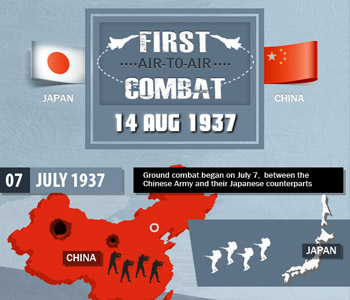Click to view full Infographic Two years before German tanks rumbled into Poland, the early stages of World War II began taking shape. Five weeks after the Japanese launched an offensive into mainland China and captured Beijing, the Nationalist Chinese Air Force opened the battle for the skies by downing six Imperial Japanese bombers. Though much of the world was still unaware of the scale of the Second Sino-Japanese War, it quickly evolved into the Pacific Theater of the last Great War. Ground combat began on July 7, when skirmishes between the Chinese Army and their Japanese counterparts elevated to a full-scale attack against Beijing and Tianjin. The Kuomintang government, led by General Chiang Kai-shek, found the Marco Polo Bridge Incident to be a step too far when it came to Japanese aggression and soon took control of the army and air force in order to respond with full force against the invaders. His first major move, launching an offensive against the Japanese Marines, opened a new front in the battle at Shanghai. As Chinese soldiers fired on opposing warships positioned near the Yangtze River, the Japanese Navy sent in fighters and bombers to push the advance back and neutralize any aerial threats on August 14, 1937. The Chinese Air Force, unwilling to become a victim without a fight, took to the skies over Shanghai to repel the A5M fighters and G3M bombers before munitions could be released over Chienchiao airfield. For their part, the Chinese were equipped with Boeing P-26 pursuit aircraft and older Curtis Hawk IIs to match up with the newer Japanese A5Ms. With the envelope closing between the hostile pilots, the world stepped into a new age: all-metal monoplanes engaged in air-to-air combat for the first time in history. Though relatively slow in comparison with their Japanese enemies, the Chinese P-26s performed admirably, shooting down six of the G3Ms before they could release a single bomb. The day would go on to be celebrated as Air Force Day in China, an acknowledgement of a cherished result in a long war that left many dead as the Japanese war machine overran nearly everything in its path. With more than 200,000 troops on the ground by the end of the Battle of Shanghai, the Japanese ranks soon swelled to nearly 350,000. In the coming months, the Imperial Japanese Army would capture Nanking and kill more than 300,000 Chinese. Massively undertrained and unable to build its forces at a rate near that of their enemies across the Sea of Japan, the Chinese received help from the Soviet Union and United States in the form of newer, faster aircraft but it would do little good. By 1941, much of eastern China and the Vietnam peninsula were in Japanese hands. Only the eventual involvement of the American Navy would help end the fight. After millions of lives lost by men from all over the globe throughout the Pacific Theater, the Japanese surrendered to the Allies, eight years to the day of that first dogfight over Shanghai.
August 14, 1937 CE – The First Air-to-Air Combat of World War II
Click to view full Infographic Two years before German tanks rumbled into Poland, the early stages of World War II began taking shape. Five weeks after the Japanese launched an…
397
